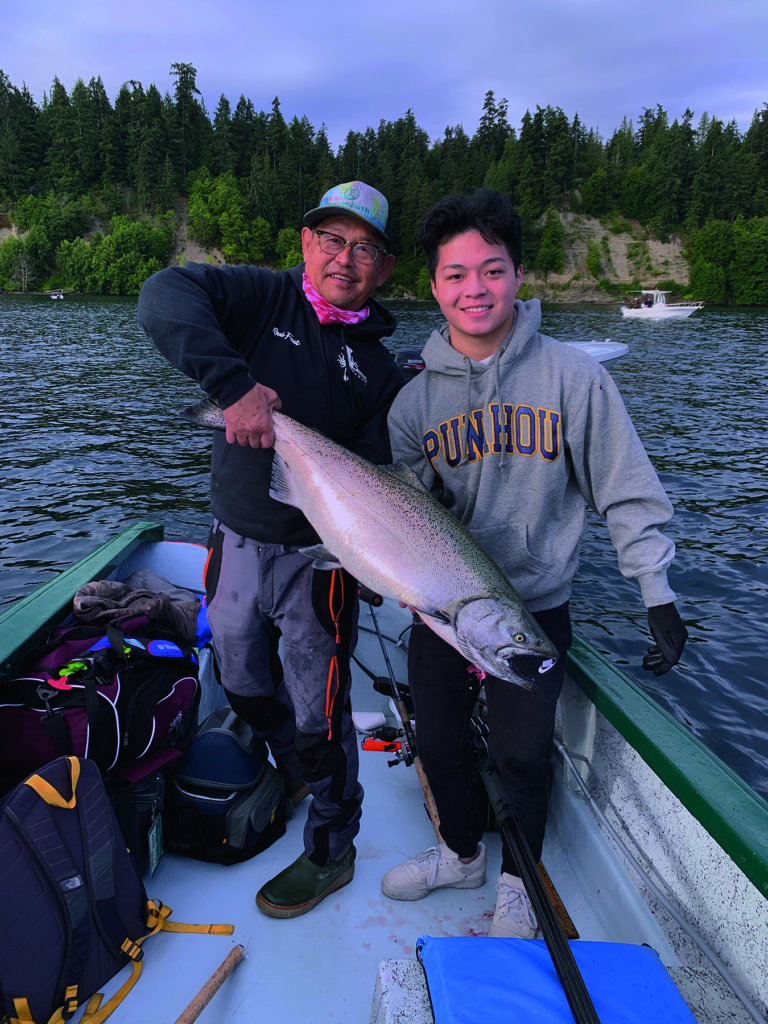
MARK YUASA shares his favorite spots for nabbing winter Chinook in the fishing playground of Marine Catch Area 13.
In Washington, winter Chinook options are currently limited to southern Puget Sound after the Washington Department of Fish and Wildlife (WDFW) decided in mid-January to temporarily suspend fishing in central Puget Sound in order to preserve opportunities for later in the season. Luckily, the opportunistic can still hook some chinook in Marine Catch Area 13.
Initial data for the first six fishing days after central Puget Sound (Marine Catch Area 10) opened on January 1 showed catch encounters had almost reached the halfway point of the guideline threshold, according to WDFW fishery managers. Fishing had been limited to three days a week and the agency instituted a daily catch limit of one salmon in hopes of stretching out time on the water after the 2021 winter season lasted just 18 days. WDFW understands it is a priority for the Area 10 fishery to be open in February and March, a timeframe when winter Chinook tend to be larger in size and the weather is more suitable. WDFW plans to make an announcement of a reopening date for Area 10 very soon. In the meantime, salmon anglers in the greater Tacoma and Olympia region have traditionally liked to keep mum about the fishing playground known as Marine Catch Area 13, which is open year-round for salmon. But word has gotten out about the potential of this fishery, and its relatively protected waters from winter’s ever-present blustery weather and rough seas make it an awesome area to fish.
Most winter Chinook are delay released from local hatcheries and spend their entire lives in the fertile waters of the Puget Sound, gorging on herring and candlefish, their primary food source. These winter fisheries target abundant hatchery-produced salmon, while protecting wild stocks of concern that must be released if caught.
Whenever it comes time to bundle up and cast out your line, here are a few of my favorite winter spots south of the Narrows Bridge in Area 13:
Fox Island Area: A popular fishing hole is Point Gibson near the “Big Rock” on the southeastern shoreline during an incoming tide. Also, try heading to Fox Point on northeastern side on an outgoing tide. Here the bottom drops off sharply from 90- to 150-feet, and Chinook like to lurk along those deeper ledges. Another option is around Fox Island’s public fishing pier (commonly dubbed the concrete dock) located on the eastern shoreline, which can be good an hour or two before and after an incoming tide.
Other notable southern Puget Sound places to target winter Chinook are Point Fosdick, Anderson Island, Lyle Point, Budd Inlet, Devil’s Head and Johnson Point.
In my March column, we’ll dive into another winter/spring salmon fishery that opens along the western Strait of Juan de Fuca at Sekiu, and online at nwyachting.com, you will find some of my best tips for nabbing winter Chinook. I’ll see you on the water soon!
TIPS TO CATCH WINTER SALMON
Mark Yuasa’s tried-and-true methods for angling some winter Chinook.
- Locating baitfish schools is the most important factor to locate the Chinook as they’re voracious feeders of herring and candlefish and other small crustaceans.
- Winter Chinook often stay near or right on the bottom preying on their feed, so keeping your presentation bouncing right in front of them will likely lead to more hook-ups.
- Understanding where to fish during an incoming or outgoing tide is key, and so being out at the crack of dawn like you’d normally do in the summer isn’t necessary. Winter Chinook are sometimes predictable and knowing where they bite at a certain time of the day during a specific tide change means it’s almost likely they’ll do the same the following day.
- This also means studying tidal movements and viewing topographic maps to find out where drop-offs, ledges, and underwater structures could lead you to areas where the salmon inhabit. Also, be observant of what others are doing in their boats and even asking them for tips—anglers are usually friendly—could provide benefits in the long run.
- There are three techniques—trolling, drift mooching, and jigging—utilized to catch winter chinook:
- Downrigger trolling allows you to cover a lot of territory, especially in the winter months when baitfish schools can be sparse. Use plastic squids, spoons,plugs or a cut-plug or whole herring along with a flasher or dodger that’s set about 8 to 20 feet behind a 10- to 15-pound downrigger lead ball. Make sure your lead ball is bouncing right off or near the bottom.
- Drift or motor mooching with herring or a candlefish is an effective way to catch fish. It involves using a cut-plug or whole herring and working it up and down the entire water column. A six- to eight-foot leader tied to tandem 2/0 or 3/0 barbless hooks is attached to a 3- to 6-ounce banana weight. The weight size depends on the wind and current, but keeping a 45-degree line angle is critical. Those who mooch will often back up their boat to keep the right line angle.
- A third technique is jigging with 3- to 6-ounce Point Wilson Darts, Crippled Herring and Buzz Bombs jigs in candlefish or herring patterns. A reminder to take off the store-bought illegal treble hooks and add 2/0 and 3/0 barbless style hooks.